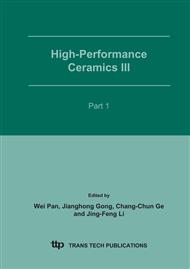p.15
p.19
p.23
p.27
p.31
p.35
p.39
p.43
p.47
Microwave Dielectric Characteristics of BaO-Nd2O3-TiO2 Nano-Particles by Millimeter-Wave Sintering
Abstract:
By means of 34.5 GHz millimeter-wave (MMW) sintering, BaO-Nd2O3-TiO2 microwave ceramic dielectric was prepared from nano-particles of the xBaO×(0.35-x)Nd2O3×0.65TiO2 ternary compound, which possess fine grain, low porosity and good dielectric characteristics. The materials which have ultra-low dielectric loss can be fired by MMW heating at very high frequency, which is unable to be done by normal microwave heating at 2.45 GHz. The sintering temperature is 160 ~ 400°C lower than that of normal firing. The ceramic sample consists of the main phase of Nd2Ti2O7 with perovskite-like layer structure (PLS) and the secondary phase of BaNd2Ti4O12 (Ba4.5Nd9Ti18O54)with perovskite-like tungsten bronze structure, being the same as the results from normal sintering. The excellent microwave characteristics were observed.
Info:
Periodical:
Pages:
31-34
Citation:
Online since:
February 2007
Authors:
Price:
Сopyright:
© 2005 Trans Tech Publications Ltd. All Rights Reserved
Share:
Citation:


